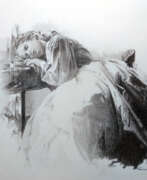Russian romanticism

Russian romanticism
Russian Romanticism was a pivotal artistic and intellectual movement that emerged in the late 18th century, gaining prominence in the early 19th century. This period in Russian art is characterized by a profound emphasis on emotion, individualism, and a deep reverence for nature, aligning with the broader Romantic movement that swept across Europe.
The essence of Russian Romanticism in painting is encapsulated by its departure from the classical adherence to formality, embracing instead a more expressive and emotive style. This artistic orientation was not just a stylistic choice but a philosophical stance that prioritized subjectivity and the exploration of human passions over rationality and the restrained ideals of Neoclassicism .
Prominent figures like Orest Adamovich Kiprensky and Karl Bryullov played significant roles in shaping the Romantic landscape in Russia. Kiprensky, known for his masterful portraits, brought to life the emotional depth and complexity of his subjects, thereby exemplifying the Romantic fascination with individual moods and inner conflicts. Meanwhile, Bryullov's monumental work, "The Last Day of Pompeii," dramatically captures the terror and chaos of historical calamity, mirroring the Romantic preoccupation with the tragic and the sublime.
Works from this era are held in high esteem and are prominently featured in major museums, including the State Russian Museum and the Tretyakov Gallery, ensuring that the passionate spirit of Russian Romanticism continues to inspire and resonate with audiences worldwide.
For those deeply moved by the evocative power of Russian Romanticism and wishing to explore more about its profound influence on art and culture, signing up for updates on exhibitions and auctions can be an enriching pursuit. By subscribing, enthusiasts and collectors can stay informed about the latest discoveries and sales related to this captivating artistic period.
| Country: | Europe, Russia, Russian Empire |
|---|---|
| Start of the period: | XVIII century |
| End of the period: | XIX century |


